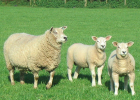
The breed's high prolificacy means that it can be used to produce commercial crossbred ewes that will almost certainly have a high output performance. Generally the prolificacy of the crossbreds is the mean of the two parents.
Crosses with Terminal Sire breeds, especially the Texel, are popular. The resultant crossbred ewe is of medium size and the surplus wether lambs are attractive meat animals. Usually these are sourced from a flock of Cambridge ewes maintained on the same premises but in a few cases they result from Cambridge rams being used on young Texel ewes to ensure easy lambing. It is also possible to adopt a rotational crossbreeding programme with the proportion of Cambridge genes fluctuating between 67% and 33% in successive generations.
There are several large flocks of Cambridge × Texel (Camtex) ewes in the country achieving an output of 1.9 lambs per ewe. Lambs from this cross are usually sired by a Terminal Sire breed ram and so have top carcass grades.
Cambridge rams have also been crossed with Hill breeds especially in Wales. Some resourceful breeders have gone a step further and mated first cross Cambridge × Hill ewes with Texel rams to produce a commercial ewe that better suits their circumstances.
There is reliable evidence too that the Cambridge × Dorset Horn crossbred lambing in early December will achieve a lambing percentage near 190%.
Finally Cambridge rams have been used on a variety of miscellaneous crossbred ewes to boost prolificacy, reduce lambing problems and in some cases to avoid the need to purchase female replacement stock.




